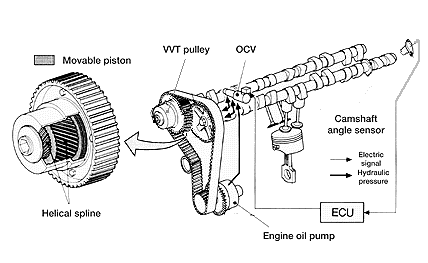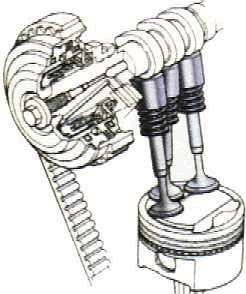Our favorite debate, is it Honda or Toyota. Well, instead of penning down our Weekend road stints on Margalla road, i say we start by comparing the two Technically. To make it interesting, i am going to penn down all that i know about Toyota and a li'll bit about HOnda's and i would welcome people with actual knowhow to write in and compare the two. I am writing this impartially and at the end of it, it'll be for you to decide what is better, but please, i implore you, let this not be another fatality in the whimsical not to mention rhetorical non factual debate about Toyota or Honda. Please contribute if you have something useful to write otherwise, just suffice yourself on reading and cursing the desired.
Okay so i'll start with the comparison of the Variable Cam timing systems on both the manufacturers and progress through engine lineup, heritage, acclaim, sales and niche following.
VVTI:
The VVT-type system has been around and in use by various companies for at least 40 years that I know of. VVT is simple and fairly effective. It consists of only two main parts; an 'oil control solenoid' and the VVT mechanism itself.
The early VVT system was relatively simple, ie, at a specific rpm (~4400rpm on the 20 valve 4AGE's) the computer signals the OCV to open, this lets oil pressure go through a special gallery in the inlet cam bearing, through the centre of the inlet cam to the VVT pulley. There's a small piston in the VVT pulley, and once it gets enough pressure behind it, it starts to move outwards, causing the outer part of the pulley to turn in relation to the inner part, due to the helical spline that guides the piston's fore & aft movement. So, when the computer signals for the VVT to operate, the OCV opens and thus causes the VVT pulley to advance the inlet cam timing by 30°, reference the crankshaft. (15° on the pulley itself)

The rpm at which this happens is worked out by running the engine on a dynamometer with the inlet cam in both the fully advanced and fully retarded positions. Since the two different cam timing's will make different power throughout the rev range, (advanced inlet give more top end power at the expense of low end power, and vice-versa) there is a point where the power will be identical for both cam settings, and this is where the VVT is programmed to operate.

Because the power output is the same with the VVT in either position, you can't feel anything when it happens. You can, however, hear a change in engine note, just before there's a big increase in power!Being an older version, the VVT worked in wither ON or OFF between the 30degree advance and no in betweens
It shows the second evolution of the VVT system - called VVT-i - where instead of the simple 'on' or 'off' positions of the earlier VVT system, this version can make the inlet cam retard/advance to any angle between the maximum limits, and to do this the camshaft has a position sensor on the back of the head. This means that the engine is even more flexible in it's power output than before.There are two engines that commonly use the VVTL-i system, the 1ZZ-FE/2ZZ-GE series and the latest (in 1999 & onwards) 3SGE, as used in the sporty Altezza. The early generation 'redtop' four 3SGE's have a single inlet VVT-i and the later 'blacktop' generation four 3SGE's have dual VVT-i controllers, one on the inlet and the other on the exhaust cam, and makes 200hp from 2 litres. So, using VVT technology, it's pretty easy to get around 100hp per litre. Toyota has now gone to the third evolution of the VVT, and it not only alters the cam timing, but it also alters the valve lift as well.
VTEC:
The V-TEC system is far more complex than the VVT, but it allows you to not only alter the cam timing, but to alter the valve duration and lift at well. It's really like having two engines in one. Compared to the earlier VVT, the VTEC Crapped all over it till Toyota cam to its senses and rivalled the V-TEC with the VVTL-i.
What happens when the engine computer decides to make the V-TEC shift to 'grunt' mode is this - Up until that point, the valves are operated by the pair of cam followers that run directly on top of each valve. A hydraulic valve opens in the head somewhere, allowing oil pressure to fill the pivot shaft that the cam followers swing off. The oil is then directed to a tiny set of pins that live in the inner follower. These pins push outwards when the valves are shut, locking the inner cam follower to the two outer followers. The inner follower runs on a cam lobe that sits between the outer two, and is much bigger. This is the lobe that has the larger duration and lift, and so suddenly allows the engine to breath a lot better.
You can see from the above pictures, and the one below that there's been a huge amount of effort to make it all work. The cam followers all have small rollers, to reduce friction and allow for a larger cam lobe.
Honda have also made a single cam version of the V-TEC, (V-Tir system??) though it only operates on the inlet cam valve timing/duration/lift. As with the twin cam system, it is quite elegant but has many small parts operating under high loads and speeds.

The point at which the V-TEC system operates is a purely rpm derived point, as was the VVT system, and is done for exactly the same reasons. Because of this, you will not gain anything on a standard engine (either type) by using one of the aftermarket controllers that let you alter the rpm at which the systems operate. All you'll do is create an unpleasant dead spot in the torque curve.
The Toyota engines run slightly more aggressive cams than the Honda's, and so at lower revs they seem to (anecdotal evidence here ...) be a bit more pleasant to drive and make a little more power. There's also less of a transition when the cam shifting systems operate, but this is obvious due to the Honda system swapping over to a much more 'racy' cam profile.
PROS
Both systems allow you to have an engine that's quite a lot more powerful and yet still driveable than a 'conventional' engine would otherwise possibly be. The V-TEC is the obvious choice for outright power, and the Honda's certainly seem to rev a heck of a lot more than the Toyota's do. (The S2000 red lines at a stratospheric 9,000rpm - stock!)
CONS
You are pretty much stuck with limited modifications to the engine, eg, air filters, extractors, etc, to get more power. The reason for this is the very system that give the engine all that extra power - The cams & VVT/V-TEC. You can of course use larger cams to get more power, but this defeats the purpose of having the VVT/V-TEC in the first place. You'll most likely lose power at low revs, and not gain a great deal at high revs. (The VVT will gain proportionally more than the V-TEC, however, as the V-TEC head is optimised - well, compromised - for the 'big' cam & 'small' cam and so using a larger cam may not help much at all)
The other concern seen is the longevity of these sorts of engines. I believe that the VVT system would be largely trouble free for the life of the engine provided that you keep the oil clean and change it regularly. Even more so with the V-TEC, as with all it's little bits & pieces in close formation in the head I'd hate to think what would happen if some of those little locking pins didn't engage properly at 6000rpm+. All that being said though,
Honda have never had a warrantee claim for any V-TEC engine in the area of the head and/or valve gear. Quite impressive.
So we see that although Toyota lacked the finesses of the VTEC in earlier versions of the VVT its more than made up for it with advent of the VVTL-i...
So its
HONDA 1
TOYOTA 1



